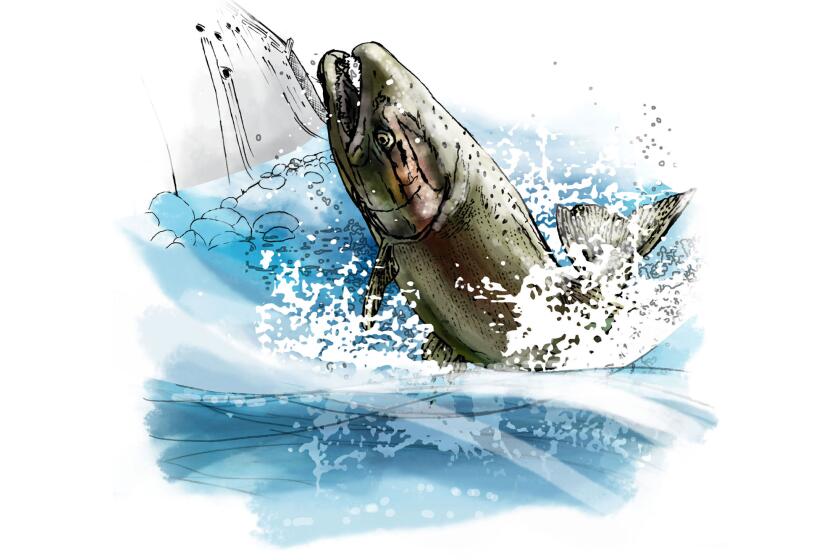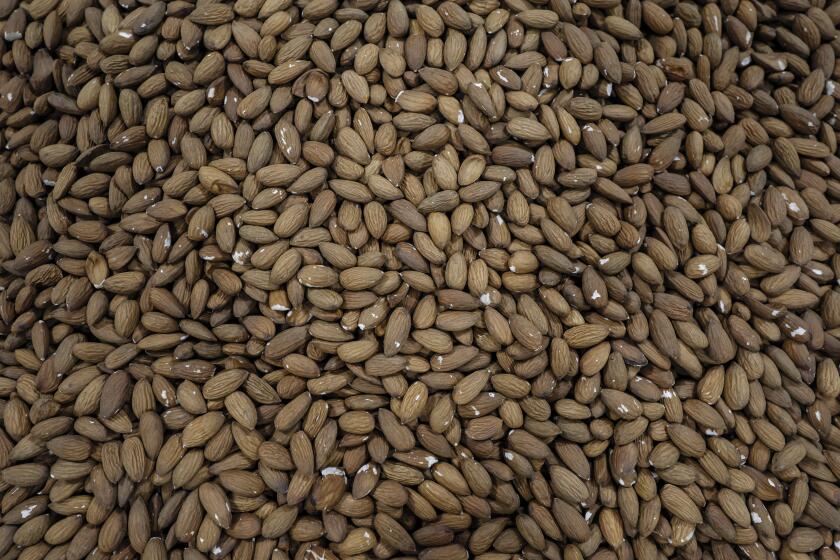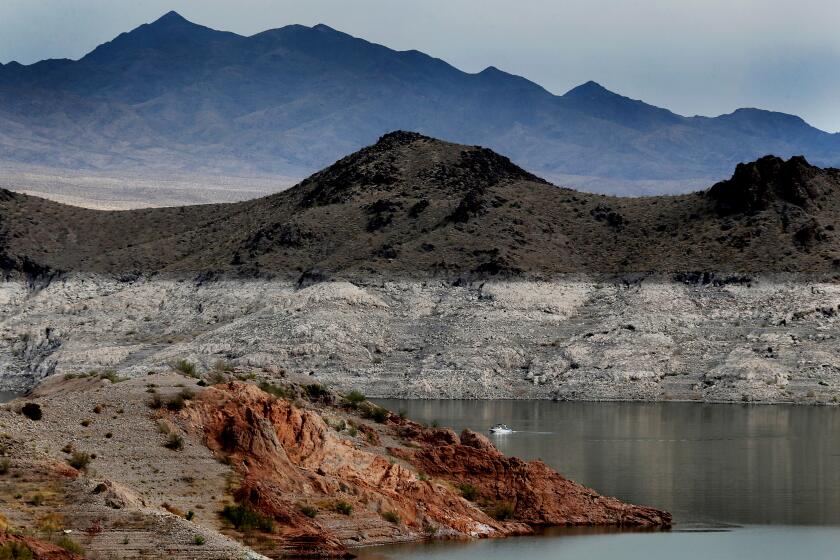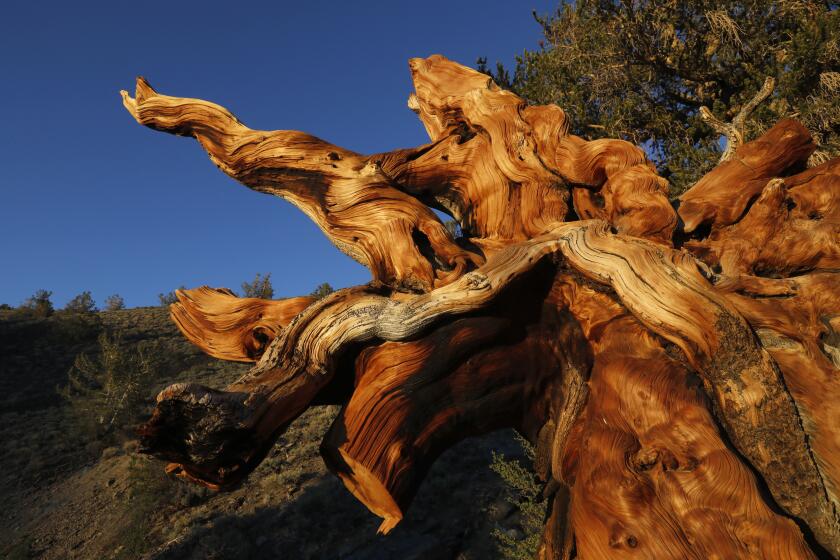Endangered salmon will swim in California river for first time in 80 years
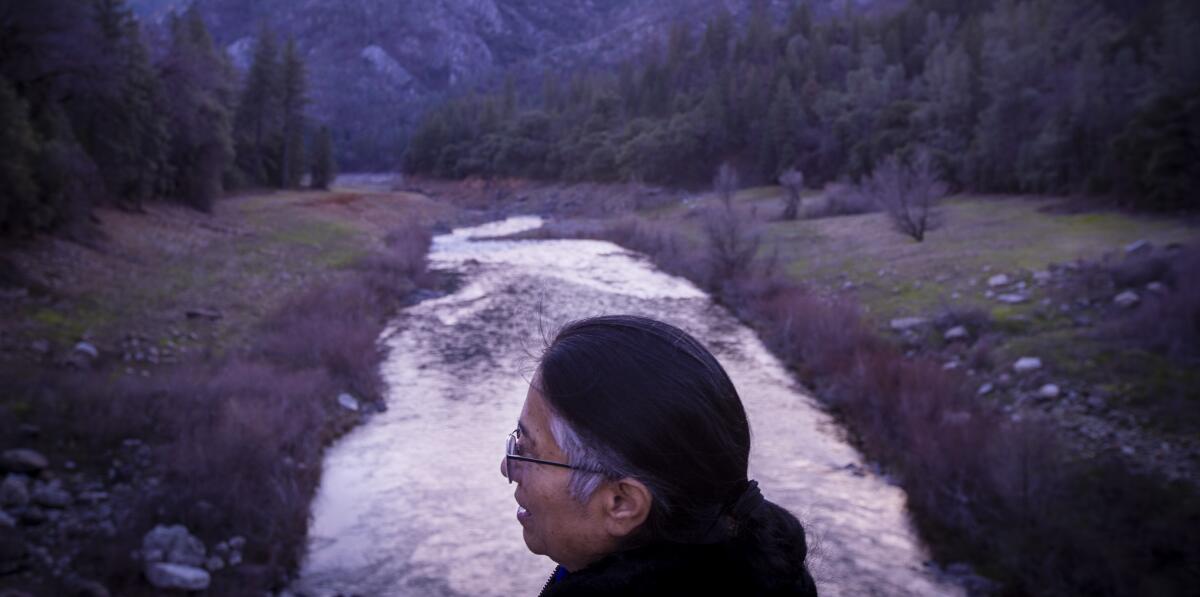
California’s Chinook salmon haven’t been able to reach the McCloud River since 1942, when the construction of Shasta Dam blocked the fish from swimming upstream and sealed off their spawning areas in the cold mountain waters near Mt. Shasta.
After 80 years, endangered winter-run Chinook are about to swim in the river once again.
State and federal wildlife officials this week collected about 20,000 winter-run salmon eggs from the Livingston Stone National Fish Hatchery near Redding and drove them for three hours to a campground on the banks of the McCloud River.
Members of the Winnemem Wintu Tribe, who have long sought to return salmon to the river where their ancestors lived, held a ceremony as the eggs arrived in a cooler.
“This is history for California that we’ve done this,” said Caleen Sisk, the tribe’s chief and spiritual leader. “It’s a real blessing.”
During the ceremony this week, Sisk and others sang as two women carried the cooler with the salmon eggs, leading a procession around a fire as several children followed.
“We’re asking that the river receive these eggs,” Sisk said. “And we’ve put down that song so that they have a fighting chance.”
For the Winnemem Wintu, salmon are central to their cultural and spiritual traditions. They call the river Winnemem Waywacket, and it’s the heart of their traditional homeland, which the tribe lost when the reservoir was filled.

“Whatever happens to the salmon happens to us,” Sisk said.
She said the tribe offered prayers for the salmon to survive. And the women and children welcomed the eggs, she said, to give them a “female mothering kind of vibration.”
Two biologists lugged the cooler down a rocky slope to the riverbank and set it down next to specialized incubator tanks, where water flowing from the river was circulating through the system.
Years ago, scientists said climate change would bring a Colorado River crisis. Their warnings, which largely went unheeded, are now playing out.
Taylor Lipscomb, the hatchery’s manager, reached into the cooler and lifted out a cup filled with orange salmon eggs, then handed it to one of the children.
Each child participated, lowering a cupful into the water and tipping it until the eggs tumbled out and settled on a metal screen.
As Sisk carried a cupful to the tank, she said she was “talking to the eggs about their ancestors,” the salmon that swam there long ago.
“And just trying to give them the courage and support,” she said, “that we’re here for them and we’re going to do the best that we can.”
Winter-run Chinook salmon are increasingly struggling to survive as global warming intensifies drought conditions and extreme heat.
As dams and global warming push endangered California salmon to the brink, a rescue plan is taking shape — and a tribe pushes for recovering their sacred fish.
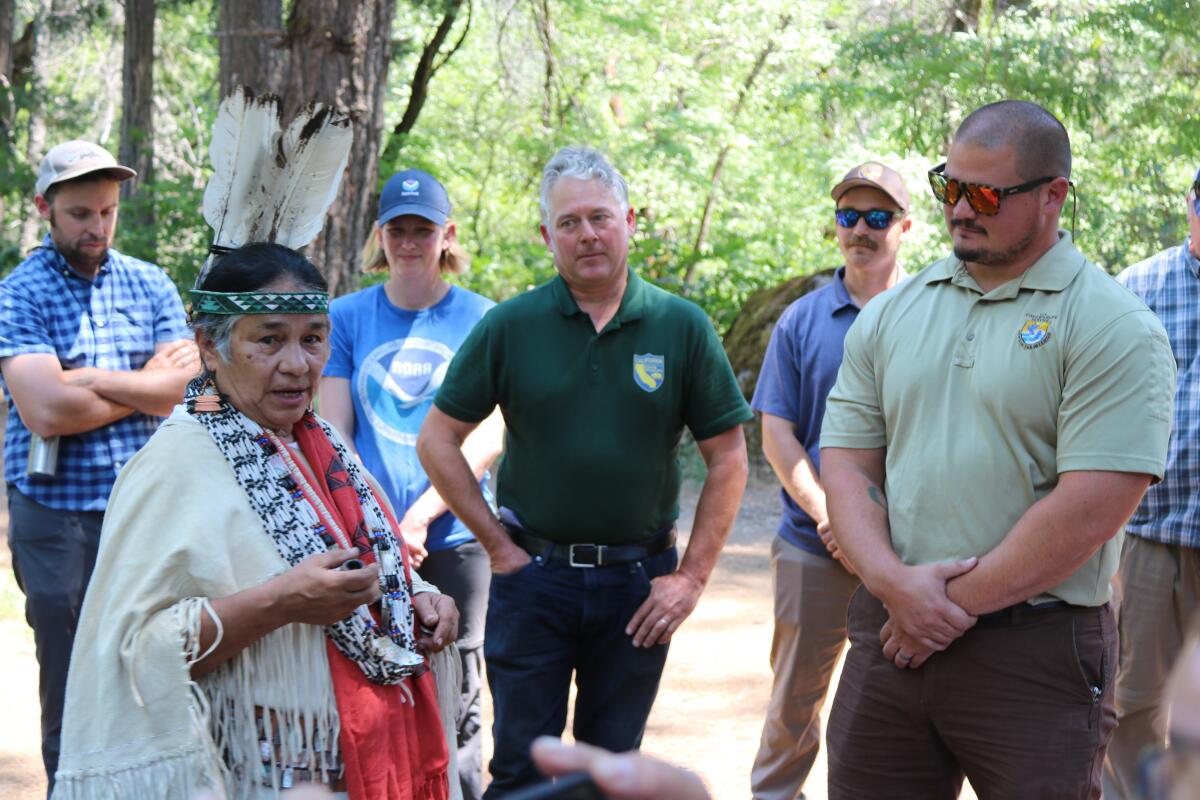
Last year, the water flowing from Shasta Dam got so warm that the Sacramento River turned lethal for winter-run salmon eggs. Most of the eggs and young fish died. State biologists estimated that only 2.56% of the eggs hatched and survived to swim downriver, one of the lowest estimates of “egg-to-fry” survival yet.
State and federal officials have been working on plans to reintroduce the endangered fish to the McCloud River. They say the effort this summer is not yet a full-fledged reintroduction, but rather an urgent response to help the salmon during a third year of severe drought.
The idea is that by moving some eggs to cooler waters, they will have better odds of surviving this summer.
Once the eggs hatch, the tiny salmon, called fry, will make their way out of the incubator system through a pipe and swim into the river.
Another shipment of 20,000 eggs will be delivered to the incubators on the riverbank in early August.
Biologists plan to use traps in the river to collect the juvenile salmon and truck them downstream of the dam. Once released into the Sacramento River, the fish can migrate to the Pacific Ocean.
As almond growers use increasingly scarce and expensive water to irrigate this year’s crop, over a billion pounds of nuts remain stranded in port.
The Winnemem Wintu Tribe is taking part in the effort along with officials from the California Department of Fish and Wildlife, the National Marine Fisheries Service and the U.S. Fish and Wildlife Service.
Tribal members and state wildlife staff have been camping by the incubators to monitor the eggs as they develop.
Chuck Bonham, director of the state Department of Fish and Wildlife, thanked the Winnemem Wintu Tribe for their guidance, which he said has helped shape the effort. In a statement, Bonham called the return of the eggs to the McCloud River “historic and healing.”
For years, the Winnemem Wintu Tribe has advocated an approach to reintroducing salmon that would involve developing a “swimway” so that fish could travel upstream and downstream on their own around Shasta Dam.
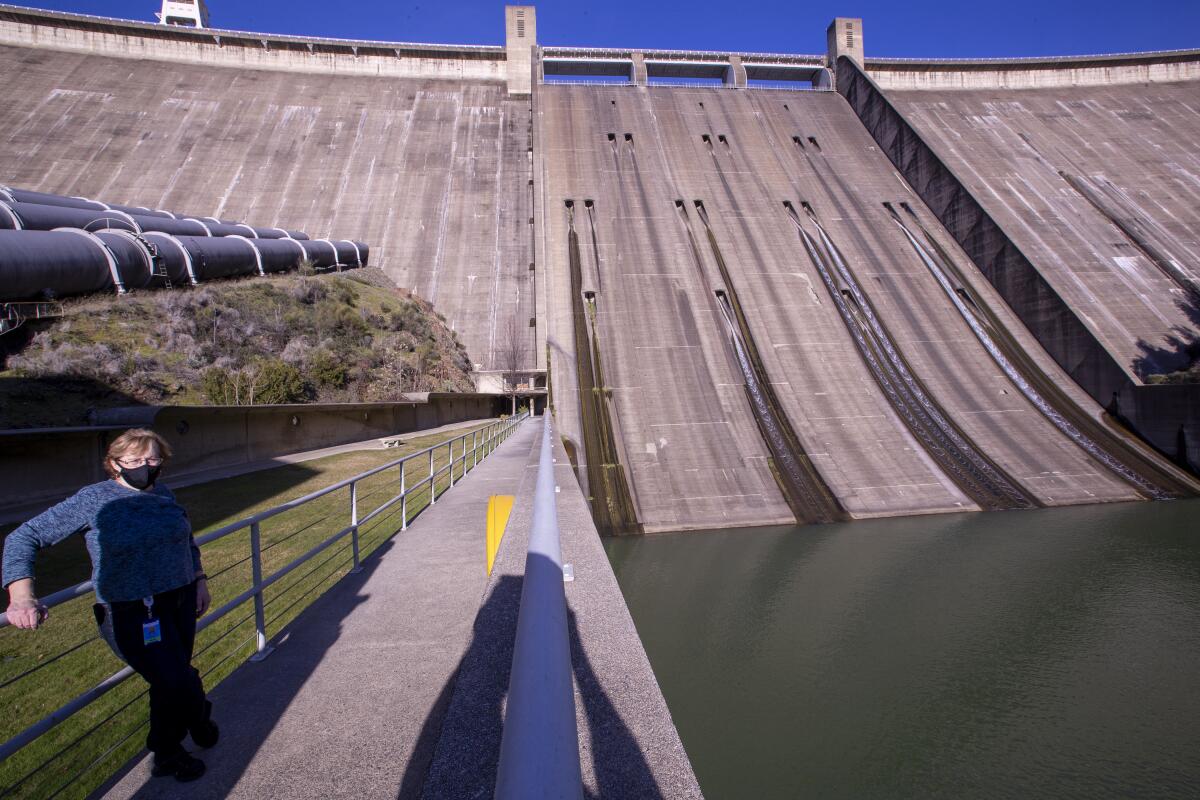
The tribe also wants to use salmon that once lived in the Sacramento River but were transplanted to New Zealand more than a century ago. The salmon have been thriving in mountain rivers in New Zealand, and the Winnemem Wintu say those eggs should be brought back.
Until recently, Sisk said she would oppose bringing hatchery-raised fish to the McCloud River. But she said the winter-run eggs are now “in dire need” of improved conditions, “otherwise they’re going to disappear.”
Recurring drought and rising temperatures have already begun to alter the landscape of California and the American Southwest, researchers warn.
“I think it’s the first step,” Sisk said. “We do have a working agreement to work on bringing our New Zealand eggs back still. And we should be able to do that within three years.”
She said the tribe also still wants to develop a passage route for fish, because they wouldn’t want the salmon to be continually hauled by truck to reach their spawning habitat.
For now, Sisk said she’s concerned about the nonnative brown trout in the McCloud and the bass in Shasta Lake, both of which feed on baby salmon. She said she hopes the little Chinook will be able to grow enough in the McCloud to give them a chance at survival.
Having young salmon in the McCloud River will enable scientists to monitor how the fish fare in their historical habitat.
Extreme drought and bark beetles now threaten California’s Ancient Bristlecone Pine Forest, home to Methuselah, a 4,853-year-old bristlecone pine.
“It’s a glimmer of hope,” Sisk said. “It’s really a dream come true.”
She said the effort came together quickly and she was stunned to see the children, including her 5-year-old granddaughter Maya, putting the eggs into the blue barrels.
“They have that connection now,” she said. “It’s something they’ll never forget their entire life.”
The eggs arrived at the start of the tribe’s seventh annual Run4Salmon, a 300-mile journey on foot, bicycle, horseback and boat, following the old path of the salmon from the McCloud River to San Francisco Bay.
On Friday, Sisk and others were on an initial leg of the journey at Lake Shasta, some in a houseboat and others paddling a dugout canoe and kayaks. She said participants plan to kayak to Red Bluff, ride bikes to Colusa and then paddle in kayaks toward Sacramento.
On July 31, they plan to finish their journey like the salmon, reaching the Pacific coast.
More to Read
Sign up for Essential California
The most important California stories and recommendations in your inbox every morning.
You may occasionally receive promotional content from the Los Angeles Times.

